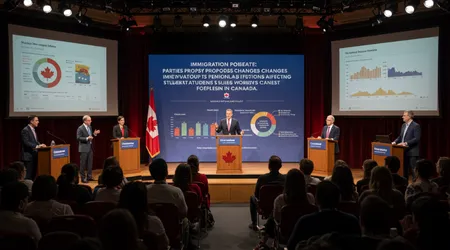Immigration Policy Debate: Parties Propose Changes Affecting International Students and Foreign Workers

The immigration policy debate in Canada has taken center stage in 2025, fueled by the federal election and pressing economic concerns.
With 3.02 million temporary residents 7.27% of the population as of January 2025, parties are proposing sweeping changes to immigration frameworks, particularly for international students and foreign workers.
This article dives into the nuances of these proposals, exploring their implications for Canada’s education sector, labor market, and global reputation.
From Liberal plans to reduce temporary residents to Conservative promises of stricter enforcement, the stakes are high.
How will these shifts redefine Canada’s role as a beacon for global talent? Let’s unpack the arguments, policies, and real-world impacts with a clear-eyed perspective.
The immigration policy debate isn’t just about numbers it’s about identity, opportunity, and sustainability.
International students, contributing billions to the economy, face uncertainty as study permit caps tighten.
Foreign workers, vital to sectors like agriculture, grapple with delays in work permit renewals.
Both groups are caught in a political tug-of-war, with parties balancing public sentiment, economic needs, and global pressures like U.S. tariff threats.
This piece offers a deep dive into party platforms, real-time impacts, and what’s at stake for Canada’s education ecosystem.
Through data, examples, and critical analysis, we’ll explore how these policies could reshape the future.
The Liberal Party’s Vision: Balancing Capacity and Compassion
Liberal Leader Mark Carney has anchored his party’s immigration policy debate stance on reducing temporary residents to below 5% by 2027.
This follows measures initiated by former Immigration Minister Marc Miller, including study permit caps that slashed approvals by 35% in 2024, with a further 10% cut planned for 2025.
The Liberals argue this ensures Canada’s infrastructure housing, healthcare, and education can support newcomers without straining resources.
For international students, this means fewer opportunities to study in Canada, particularly at smaller colleges facing enrollment limits.
Yet, the Liberal plan isn’t just about restriction. They’ve proposed streamlining pathways to permanent residency for high-skilled foreign workers, emphasizing sectors like tech and healthcare.
This dual approach curbing temporary inflows while rewarding talent aims to align immigration with labor market needs.
For example, Priya, an Indian nursing student in Ontario, hopes to transition to permanent residency after her studies, but fears tighter caps could limit her options.
The Liberals’ focus on capacity raises a question: can Canada remain a global education hub while scaling back access?
Critics argue the Liberal strategy lacks clarity on implementation. Reducing temporary residents by over 2% in two years requires precise coordination across provinces, yet details remain vague.
++ Conservatives Propose Stricter Background Checks for International Students
Universities, already strained by funding cuts, worry about revenue losses from fewer international students.
The Liberals counter that their plan prioritizes long-term sustainability, citing a 2023 report showing 26,000 Indian workers in low-wage roles under the Temporary Foreign Worker Program.
By redirecting immigration toward skilled sectors, they aim to ease public concerns about overcrowding and job competition.

The Conservative Push: Enforcement and Exclusivity
Conservative Leader Pierre Poilievre has taken a hardline stance in the immigration policy debate, vowing to “crack down on fraud” and drastically reduce temporary foreign workers and international students.
His platform limits temporary workers to niche sectors like agriculture and mandates criminal background checks for all international students.
Poilievre’s rhetoric resonates with voters frustrated by housing shortages and job competition, but it risks alienating Canada’s education sector, which relies heavily on international tuition fees.
Also read: New Rules for International Students: What’s Changing in 2025?
Consider Maria, a Guatemalan worker at a Quebec strawberry farm. Under Poilievre’s plan, her role might remain secure, but thousands in other sectors could face deportation.
The Conservative proposal to limit international students also raises red flags. In 2023, Canada hosted 1,040,985 international students, with 278,860 from India alone.
A sharp reduction could devastate universities, particularly in smaller provinces like Nova Scotia, where international tuition accounts for up to 30% of revenue.
Poilievre insists these measures protect Canadian workers, but at what cost to global competitiveness?
The Conservative plan also emphasizes border enforcement, spurred by a recent uptick in asylum seekers crossing from the U.S. amid Trump’s immigration crackdown.
While Poilievre’s focus on security appeals to some, critics argue it oversimplifies a complex issue.
The immigration policy debate here hinges on a tradeoff: short-term public approval versus long-term economic and diplomatic fallout.
Universities warn that restrictive policies could push students to Australia or the UK, diminishing Canada’s soft power.
Read more: The Role of Digital Literacy in Shaping Tomorrow’s Workforce
The NDP and Bloc Québécois: Niche Perspectives in the Debate
The NDP, led by Jagmeet Singh, offers a contrasting voice in the immigration policy debate, advocating for worker protections and regularization for undocumented migrants.
Their platform prioritizes fair wages for foreign workers and pathways to permanent residency for international students who integrate into Canadian society.
This resonates with urban voters but struggles to gain traction in rural areas, where economic concerns dominate.
The NDP’s push for inclusivity, while noble, faces logistical hurdles, as processing delays already plague work permit renewals.
In Quebec, the Bloc Québécois focuses on provincial autonomy in the immigration policy debate.
Leader Yves-François Blanchet argues Quebec should control its temporary resident quotas to preserve cultural identity.
This stance appeals to francophone voters but complicates national policy coordination.
For instance, Quebec’s universities, hosting thousands of international students, could face unique restrictions, creating a patchwork system.
The Bloc’s insular approach risks fragmenting Canada’s immigration strategy at a time when unity is critical.
Both parties highlight overlooked angles worker rights and regional identity but their influence remains limited.
The NDP’s regularization plan, for example, could help someone like Ahmed, a Syrian student working part-time in Vancouver, stay legally after his permit expires.
Yet, without broader support, these ideas may stall. The immigration policy debate thus reveals a tension: how to balance compassion, culture, and capacity in a polarized political climate.
Global Pressures and the Education Sector’s Response
Beyond domestic politics, global factors are reshaping the immigration policy debate. U.S.
President Donald Trump’s tariff threats and immigration crackdowns have driven a 27% spike in U.S. graduate applications to the University of British Columbia for 2025, as students seek stability in Canada.
However, Canada’s own restrictions could deter these applicants, creating a paradox.
Universities are caught in a bind: they need international students to offset funding cuts, but tighter policies threaten enrollment.
The education sector is pushing back.
The University of Toronto, Canada’s largest, has urged the government to reconsider study permit caps, citing a $30 billion annual economic contribution from international students.
Smaller colleges, meanwhile, face existential risks, as many rely on international tuition to survive.
A 2025 report from the Migration Policy Institute underscores this, noting that immigration debates in advanced economies increasingly focus on infrastructure strain, yet education remains a key economic driver.
To illustrate, imagine Canada’s education system as a lighthouse: it attracts global talent, guiding them to opportunity, but restrictive policies dim its beam.
If the light fades, students like Li, a Chinese engineering graduate hoping to study at Waterloo, may look elsewhere.
The immigration policy debate thus extends beyond politics it’s about Canada’s place in a competitive global talent market.
Universities are lobbying for exemptions, but their success hinges on the election outcome.
Data Snapshot: Temporary Residents in Canada
| Category | Number (2023) | Proposed Change (2025-2027) |
|---|---|---|
| International Students | 1,040,985 | 35% reduction in permits (2024), 10% more in 2025 |
| Temporary Foreign Workers | 26,000 (Indian nationals) | Liberal: Reduce to 5% of population; Conservative: Limit to niche sectors |
| Total Temporary Residents | 3.02 million | Liberal: Below 5% by 2027 |
Looking Ahead: Balancing Act or Breaking Point?
The immigration policy debate in 2025 is a high-stakes balancing act. Liberals aim for sustainability, Conservatives push enforcement, and smaller parties advocate for inclusivity.
International students and foreign workers, from Indian nurses to Guatemalan farmers, face uncertainty as Canada recalibrates its immigration system.
The education sector, a cornerstone of Canada’s economy, hangs in the balance, with universities warning of financial strain if restrictions intensify.
What’s clear is that Canada’s global reputation as a welcoming destination is at risk. The election on April 28, 2025, will determine the path forward, but the ripple effects will last years.
Will Canada prioritize short-term public sentiment or long-term economic and cultural vitality?
The answer lies in how leaders navigate this complex, emotionally charged debate. For now, students and workers await clarity, hoping their dreams of a Canadian future endure.
Frequently Asked Questions
Q: How will study permit caps affect international students in 2025?
A: The 35% reduction in 2024 and 10% cut in 2025 will limit access, particularly at smaller colleges, pushing students to compete for fewer spots.
Q: Can foreign workers still apply for permanent residency?
A: Yes, Liberals propose streamlined pathways for high-skilled workers, but Conservatives aim to restrict temporary workers, complicating transitions for low-wage roles.
Q: Why is the immigration debate so heated in 2025?
A: Housing shortages, job competition, and U.S. tariff threats amplify public concerns, making immigration a flashpoint in the federal election.
